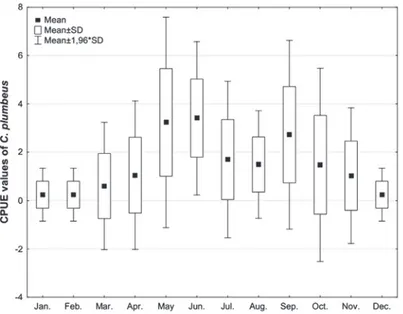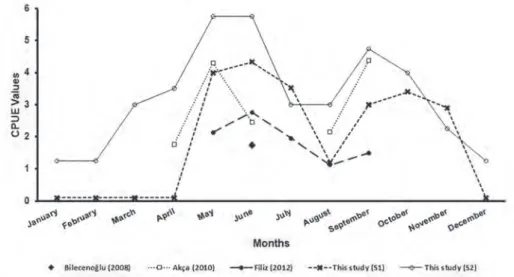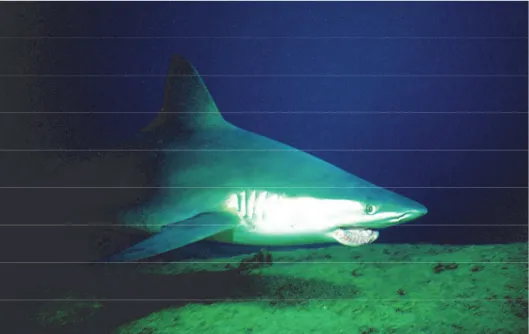Full Terms & Conditions of access and use can be found at
https://www.tandfonline.com/action/journalInformation?journalCode=tzme20
Zoology in the Middle East
ISSN: 0939-7140 (Print) 2326-2680 (Online) Journal homepage: https://www.tandfonline.com/loi/tzme20
Year-Round Aggregation of Sandbar Shark,
Carcharhinus plumbeus
(Nardo, 1827), in Boncuk
Cove in the southern Aegean Sea, Turkey
(Carcharhiniformes: Carcharhinidae)
Halit Filiz
To cite this article:
Halit Filiz (2019) Year-Round Aggregation of Sandbar Shark, Carcharhinus
plumbeus (Nardo, 1827), in Boncuk Cove in the southern Aegean Sea, Turkey (Carcharhiniformes:
Carcharhinidae), Zoology in the Middle East, 65:1, 35-39, DOI: 10.1080/09397140.2018.1540148
To link to this article: https://doi.org/10.1080/09397140.2018.1540148
Published online: 07 Nov 2018.
Submit your article to this journal
Article views: 203
View related articles
View Crossmark data
Citing articles: 1 View citing articles
0.
Taylor & Francis ~ Tllylorf.J,;i11caCr11u1,*Email: halit.filiz@mu.edu.tr
© 2018 Taylor & Francis
Year-Round Aggregation of Sandbar Shark, Carcharhinus plumbeus
(Nardo, 1827), in Boncuk Cove in the southern Aegean Sea, Turkey
(Carcharhiniformes: Carcharhinidae)
Halit Filiz
*Department of Ichthyology, Faculty of Fisheries, Muğla Sıtkı Koçman University, Muğla, Turkey (Received 7 May 2018; accepted 18 September 2018; first published online 7 November 2018)
The present study provided a two-years assessment to understand the seasonal fluctua-tions of aggregation of the Sandbar Shark, Carcharhinus plumbeus, in Boncuk Cove in the southern Aegean Sea. Underwater Visual Censuses (UVC) revealed that the spe-cies is present in the cove throughout the year but form aggregations only between March and November. Aggregation in groups was observed at a daily sea temperature above 18.1°C and this indicated a possible lower threshold for aggregations for Boncuk Cove population.
Keywords: Boncuk Bay; shark nursery area; Gökova Special Environmental
Protec-tion Area; temperature threshold
Introduction
The Sandbar Shark, Carcharhinus plumbeus (Nardo, 1827) is a widely distributed
spe-cies in temperate, tropical and subtropical regions of the Pacific, Indian, and Atlantic
Oceans, as well as through the coast line of the Mediterranean Sea, except for the Sea of
Marmara and Black Sea (Compagno, 1984). The species has a slow growth rate, older
age of maturity, small litter size and long gestation period (McAuley, Simpfendorfer,
Hyndes, & Lenanton, 2007), and these characteristics result in very low rates of
popula-tion increase and little capacity to recover from overfishing (either direct or indirect)
and other impacts such as habitat degradation (Jabado et al., 2017). The Sandbar Shark
is considered as “Vulnerable” globally (Vulnerable A2bd + 4bd) (IUCN, 2018) and
“Endangered” both in the Mediterranean Sea (IUCN, 2016) and Turkish seas (Fricke,
Bilecenoğlu, & Sarı, 2007). The Sandbar Shark has been protected in Turkish seas since
2006 (Circular 37/1 and 37/2 of the Ministry of Agriculture and Rural Affairs; Official
Gazette 24.08.2006).
Nursery areas are essential for sharks (Heithaus, 2007). The locations of nursery
ar-eas of Sandbar Shark are well documented in the western Atlantic from Cape Cod to
Cape Canaveral, including the Chesapeake Bay, Bulls Bay and Delaware Bay (see for
example Constantini and Affronte, 2003 and the reference therein). In the
Mediterrane-an Sea, Boncuk Cove in south-western Turkey (Öztürk, 2006) Mediterrane-and the Gulf of Gabès in
southern Tunisian waters (Bradai, Saidi, Bouain, Guelorget, & Capape, 2005) are
prob-ably the best known nursery areas for Sandbar Sharks. The locations of other areas in
the Mediterranean are not well known but are suspected e.g. in the northern Adriatic Sea
(Constantini and Affronte, 2003; Lipej, Maddalena, & Soldo, 2004) and İskenderun Bay
(Kabasakal, 2002). Identifying those habitats that serve as nurseries should improve the
Sandbar Shark conservation and management.
36
H. Filiz
Figure 1. Monthly CPUE values of C. plumbeus at Boncuk Cove during 2013 and 2017.
The aim of the study was to understand seasonal fluctuations in the aggregation of
Sandbar Shark in Boncuk Cove.
Material and Methods
Boncuk Cove is located on the southern side of Gökova Bay, next to Sedir Island, and is in-cluded in the Gökova Special Environmental Protection Area (SEPA) since 1988. All sportive diving activities have been prohibited since 2001, and the entire cove was declared as a No Fish-ing Zone (NFZ) in 2010. Boncuk Cove includes several habitat types such as hard bottoms with gravel and stones, rocky substrates and seagrass meadows. The surface temperature reached in the study period 29.4°C in summer and decreased to 14.0°C in winter.
The data interpreted in this study were collected from two separate surveys (S), each one last-ed one year (S1 period: May 2013–April 2014; S2 period: April 2016–March 2017). Underwater Visual Censuses (UVC) were applied to obtain presence/absence data. Two observers dived at the same time and followed a 600 m transect line from the coast out to the open sea in the north part of the cove. The number of sharks was recorded and, if possible, the individuals were photo-graphed via GoPro Hero4. Surface seawater temperature was measured in the middle of the tran-sect line at 12:00 o’clock on each survey day using Mares Dive Computer (Smart Model). In order to compare with the previous study results, a Catch per Unit Effort (CPUE) as the number of Sandbar Shark observing per hour is calculated monthly as follow: CPUE = ∑n/∑OT where, ∑n is the total number of Sandbar Sharks observed each month, and ∑OT the total observation time for each month.
Results
A total of 275 Sandbar Sharks (S1: 169 individuals; S2: 106 individuals) was counted
during the two-years study. The number of Sandbar Shark observed per day ranged
from 1 (December, January and February) to 19 (May and June). At least three
individ-uals, one male (>2.0 m TL) with scarred face and two females, were present
8 • Mean OMeantSD I Meant1,96'SD 6 II) ::,
..
.Q 4e
,:!•
•
Q, ti•
0 2"'
•
•
•
..
~ ~
~
::,•
•
.;•
> w 0 ::, ~ () -2 -4Figure 2. Comparison of monthly CPUE values in various studies carried out in Boncuk Cove.
continuously throughout twelve months. Sandbar Sharks were usually observed
swim-ming alone throughout most of the calendar year. Presence/absence data displayed a
significant correlation with seawater temperature both in 2014 (r
2= 0.57; n= 12;
p<0.001) and 2017 (r
2= 0.54; n= 12; p< 0.001). Groups of sharks (≥3 individuals) have
never been recorded below a daily sea temperature of 18.1°C (2017) and 20.0°C (2014),
suggesting a possible lower threshold (i.e. 18.1°C) in the Boncuk Cove population for
forming aggregations. The first aggregations were observed in March, peaked in May
and June, followed by lower numbers in July and August, and the numbers started to
increase again in September, then gradually declining till December (Figure 1). The
earliest date on which a Sandbar Shark group was observed during a calendar year was
11 March (2017), and latest was 7 November (2017). The largest aggregation consisted
of six individuals. Neither neonates or juvenile nor copulation was observed throughout
the two-years monitoring.
Discussion
UVC is a quick, cheap and non-destructive method associated with proven and
well-known errors (Ward-Paige, Mills Flemming, & Lotze, 2010). The methodology
pre-ferred herein was merely designed to determine shark presence/absence, so does not
provide exact number of Sandbar Sharks in the Boncuk Cove. There is an urgent need to
launch a tag-release study in the cove in order to determine the actual number of sharks.
Akça (2010) reported that the average number of Sandbar Sharks increased at
18.0°C and 23.0°C, with a distinct decrease over 23.9°C (late June). Monthly CPUE
values including the previous studies indicated a sharp decline in the period June to
August (Figure 2). Piercy, Murie, and Gelsleichter (2016) reported that the decrease in
numbers with increasing temperature is due to reproductive/birth behaviour. Indeed,
mature females observed in the cove in May and July were pregnant (Filiz, 2012). It is
likely that these females become pregnant in the previous season, move to Boncuk Cove
for birth and give birth in June or the following months. Piercy et al. (2016) recorded
that egg production started in January and lasted until May, while parturition occurred
in the south-eastern Atlantic Ocean and the Gulf of Mexico in June. Within a period of
6 5 U> 4
.,
:, ti >3 w :::> a.. 02·
~---
IC.
__
_.P./
/
\._\
--
----
__..
-
--
....
;//
··-... \ ._..
_,,,,,,
,.
--...
,,
.,,,,"'
·o
,
\, _/
/ j r ' ..._ \ d 0i
•
' ,
\.
,'
....
i
~~~!
,
0 ... ==---==---===---Months38
H. Filiz
Figure 3. A male Sandbar Shark observed during 12-months in the Boncuk Cove with scarred face (Credit: archive of Frank Diestel, Holger Lukas & Peter Rauhut).
more than two years of reproductive cycle (McAuley et al., 2007), females experience
pregnancy from July till June of the following year, and birth takes place in late June
(Piercy et al., 2016). The decrease in numbers, which was observed in July and August
(Figure 2) supports the possibility that the females may leave the cove to birth and
probably go to deeper parts of Boncuk Cove or to other still unknown areas. Occasional
observations of C. plumbeus have been reported by divers and fishers in the Gökova
SEPA. To find out this, it would be necessary to monitor the movements of Sandbar
Sharks by telemetry and to study the deeper parts of the cove with underwater
observa-tion cameras. Since Sandbar Sharks have also been observed in other areas such as
Dalaman, Hisarönü Bay and Datça (Filiz, unpubl. data), a more spatially extended study
is needed.
Funding
The present study compiled the data from two projects carried out with the financial support from Muğla Sıtkı Kocman University Scientific Research Projects Coordination Office, project num-bers BAP 2013/07 and 2015/220.
Acknowledgements
I would like to thank the field teams, especially Anıl Gülşahin, Harun Güçlüsoy, Hasan Cerim, Nilay Akça, Ozan Veryeri and Umut Uyan. I also would like to thank the Ministry of Environ-ment and Urbanization, General Directorate for Protection of Natural Assets (GDPNA) and the Ministry of Agriculture and Rural Affairs, General Directorate of Protection and Control for providing us with the permissions for the surveys.
Disclosure statement
References
Akça, N. (2010): Underwater observations on the bioecology of Carcharhinus plumbeus (Nardo,
1827) inhabiting Boncuk Bay (Gökova Gulf) [Boncuk Koyu'ndaki (Gökova Körfezi) Car-charhinus plumbeus (Nardo, 1827) biyoekolojisi üzerine sualtı gözlemleri]. Adnan Menderes
University: Thesis for Higher Education.
Bilecenoğlu, M. (2008): Project of Conservation and Monitoring of Sandbar Shark
(Carcharhi-nus plumbeus) in Boncuk Bay in Gökova Special Environmental Protection Area. Ministry of
Environment and Urban Planning. https://webdosya.csb.gov.tr/db/destek/editordosya/boncuk_ ingilizce.pdf.
Bradai, M. N., Saidi, B., Bouain, A., Guelorget, O., & Capape, C. (2005): The Gulf of Gabès (southern Tunisia, central Mediterranean): nursery area for sandbar shark, Carcharhinus
plumbeus (Nardo, 1827) (Chondrichthyes: Carcharhinidae). Annales, Series Historia Natu-ralis, 15, 187–194.
Compagno, L. J. V. (1984): FAO species catalogue. Vol. 4. Sharks of the world. An annotated
and illustrated catalogue of shark species known to date. Part 2. Carcharhiniformes. Rome:
Food and Agriculture Organization of the United Nations.
Constantini, M., & Affronte, M. (2003): Neonatal and juvenile sandbar sharks in the northern Adriatic Sea. Journal of Fish Biology, 62, 740–743.
Filiz, H. (2012): Monitoring of Sandbar Shark (Carcharhinus plumbeus) in Boncuk Bay in
Göko-va Specially Environmental Protected Area (Report of 12 May – 28 September). National
System of Marine Protected Areas. http://dcm.dka.gov.tr/App_Upload/G%C3%B6kova %20%C3%96%C3%87K%20B%C3%B6lgesi%20Kum%20K%C3%B6pekbal%C4%B1%C4 %9F%C4%B1%202012%20Raporu.pdf [in Turkish].
Fricke, R., Bilecenoğlu, M., & Sarı, H. M. (2007): Annotated checklist of fish and lamprey spe-cies of Turkey, including a Red List of threatened and declining spespe-cies. Stuttgarter Beiträge
zur Naturkunde, Serie A (Biologie), 706, 1–169.
Heithaus, M. (2007): Nursery areas as essential shark habitats: A theoretical perspective.
Ameri-can Fisheries Society Symposium, 50, 3–13.
IUCN (2016): The conservation status of sharks, rays and chimaeras in the Mediterranean. Mala-ga: IUCN Centre for Mediterranean Cooperation.
IUCN (2018): The IUCN Red List of Threatened Species. Version 2016-3. <www.iucnredlist.org> (Accesssed 10 May 2018).
Jabado, R. W., Kyne, P. M., Pollom, R. A., Ebert, D. A., Simpfendorfer, C. A., Ralph, G. M., & Dulvy, N. K. (2017): The conservation status of sharks, rays, and chimaeras in the Arabian
Sea and adjacent waters. Abu Dhabi: Environment Agency & Vancouver: IUCN Species
Survival Commission, Shark Specialist Group.
Kabasakal, H. (2002): Elasmobranch species of the seas of Turkey. Annales, Series Historia
Naturalis, 12, 15–22.
Lipej, L., Maddalena, A., & Soldo, A. (2004): Sharks of the Adriatic Sea. Kopa: Knjiznica An-nales Majora.
McAuley, R. B., Simpfendorfer, C. A., Hyndes, G. A., & Lenanton, R. C. J. (2007): Distribution and reproductive biology of the sandbar shark, Carcharhinus plumbeus (Nardo), in Western Australian waters. Marine and Freshwater Research, 58, 116–126.
Öztürk, B. (2006): Save the sandbar sharks of Boncuk Bay, Turkey. Pp. 42–47. In N. Başusta, Ç. Keskin, F. Serena & B. Seret (Eds), Proceedings of the International Workshop on
Mediter-ranean Cartilaginous Fish with Emphasis on Southern and Eastern MediterMediter-ranean. İstanbul:
Turkish Marine Research Foundation.
Piercy, A. N., Murie, D. J., & Gelsleichter, J. J. (2016): Histological and morphological aspects of reproduction in the sandbar shark Carcharhinus plumbeus in the U.S. south-eastern Atlantic Ocean and Gulf of Mexico. Journal of Fish Biology, 88, 1708–1730.
Ward-Paige, C., Mills Flemming, J., & Lotze, H. K. (2010): Overestimating fish counts by non-instantaneous visual censuses: Consequences for population and community descriptions.


